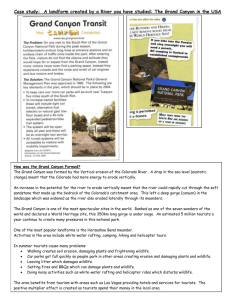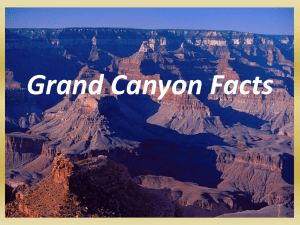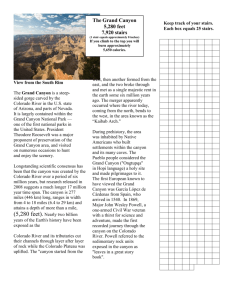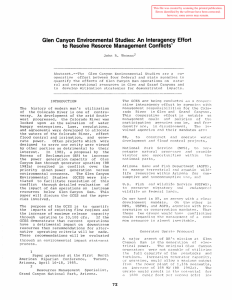Document 10529929
advertisement
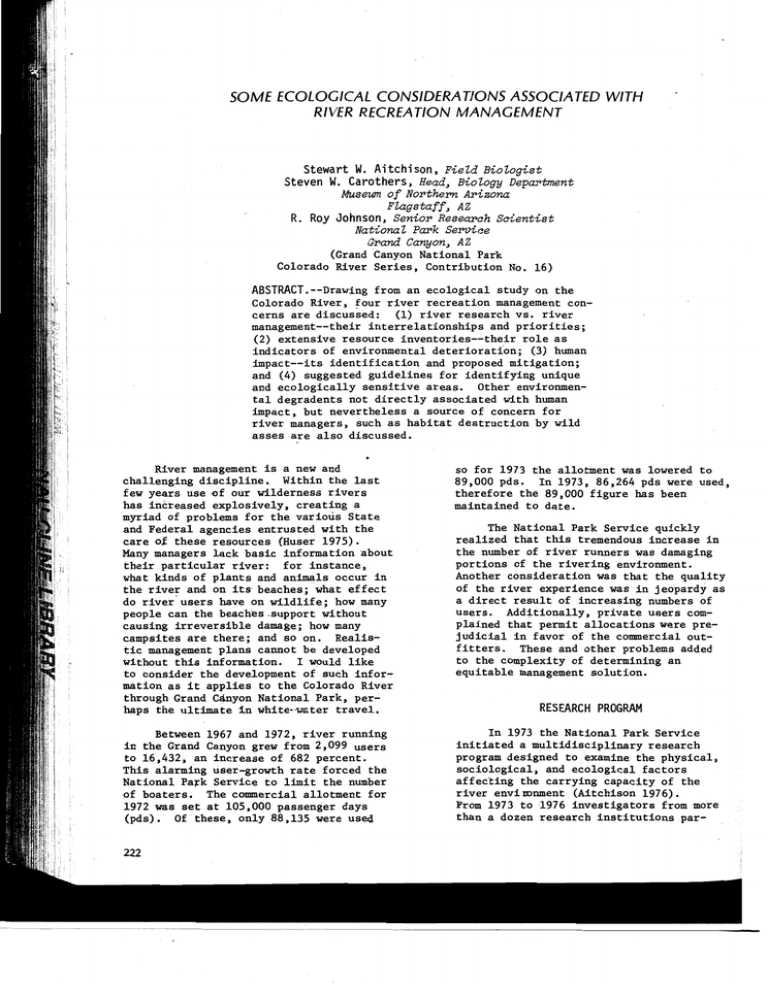
SOME ECOLOGICAL CONSIDERA TlONS ASSOCIATED WITH RIVER RECREA nON MANAGEMENT Stewart W. Aitchison, Field Biologist Steven W. Carothers, Head. Biology Department Museum of Northern Arizona Flagstaff. AZ R. Roy Johnson, Senior Research Scientist National Park Service Grand Canyon. AZ (Grand Canyon National Park Colorado River Series, Contribution No. 16) ABSTRACT.--Drawing from an ecological study on the Colorado River, ~our river recreation management con­ cerns are discussed: (1) river research vs. river management--their interrelationships and priorities; (2) extensive resource inventories--their role as indicators of environmental deterioration; (3) human impact--its identification and proposed mitigation; and (4) suggested guidelines for identifying unique and ecologically sensitive areas. Other environmen­ tal degradents not directly associated with human impact, but nevertheless a source of concern for river managers, such as habitat destruction by wild asses are also discussed. River management is a new and challenging discipline. Within the last few years use ~f our wilderness rivers has increased explosively, creating a myriad of problems for the various State and Federal agencies entrusted with the care at these resources (Huser 1975). Many managers lack basic information ~bout their particular river: for instance, what kinds of plants and animals occur in the river and on its' beaches; what effect do river'users have on wildlife; how many people can the beaches-support without causing irreversible damage; how many campsites are there; and so on. Realis­ tic management plans cannot be developed without this information. I would like to consider the development of such infor­ mation as it applies to the Colorado River through Grand Canyon National Park. per­ haps the ultimate l.n white-·Vc;.ter travel. so for 1973 the allotment was lowered to 89,000 pds. In 1973, 86,264 pds were used, therefore the 89,000 figure has been maintained to date. Between 1967 and 1972, river running in the Grand Canyon grew from 2,099 users to 16,432, an increase of 682 percent. This alarming user-growth rate forced the National Pa~k Service to limit the number of boaters. The commercial allotment for 1972 was set at 105,000 passenger days (pds). Of these, only 88,135 were uSeQ In 1973 the National Park Service initiated a multidisciplinary research program designed to examine the physical, sociological, and ecological factors affec-ting the carrying capacity of the river enviIDnment (Aitchison 1976). From 1973 to 1976 investigators from more than a dozen research institutions par­ 222 The National Park Service quickly realized that this tremendous increase in the number of river runners was damaging portions of the rivering environment. Another consideration was that the quality of the river experience was in jeopardy as a direct result of increasing numbers of users. Add~tiona1ly, private users com­ plained that permit allocations were pre­ judicial in favor of the commercial out­ fitters. These and other problems added to the complexity of determining an equitable management solution. RESEARCH PROGRAM ticipated in this project (Johnson and Martin 1976). The road from recognition of a prob­ lem through research to development of management alternatives and then, finally to actual implementation of a management policy is long and difficult. River recre­ ation on the Colorado River within the Grand Canyon has proven to be no exception. User Impact Information concerning the spatial use patterns of the river runners was sought. Through a "visitor usage card" given to each trip leader, data on campsites used, number of people in party, whether or not a wood fire was built, whether or not the contents of the portable toilet were buried, etc., were obtained. Surprisingly, the results showed that more than 300 camp­ sites were used along the 280 river miles between Lee's Ferry and Pierce Ferry. The next obvious step was to identify and cate­ gorize the types of human impact. Impacts or problems discovered included fire, lit­ tering, trampling of vegetation, and human waste disposal. Fire is integral to any natural terres­ trial ecosystem. However, man-caused fires are generally detrimental. In riparian systems impact may range from small sand­ scarred fire-rings to entire stands of beach vegetation being consumed in a holo­ caust. In Grand Canyon, fires have been caused by careless burning of toilet paper. Short-term biological effects may include elimination of actual or potential wild­ life nesting sites, foraging sites, and displaying sites. Large burns may kill or force movement of certain animals and may encourage the introduction of non-native pioneer species. Littering, and this includes the practice of dumping juices out of canned food and leftover organic waste at camp­ Sites, may increase populations of cer­ tain noxious insects or vertebrates. In the Grand Canyon, heavily used campsites seem to have correspondingly higher den­ sities of harvester ants (Pogonomypex californiaus) ~ commonly known as red ants. Because of its painful, toxic sting, this species presents a minor health hazard to the camper. The flesh fly (Sapcophagidae) and blow fly (CaZZiphoPidaei populations also show this increase at "messy" campsites. These insects could become a source of fly-vectored diseases. The increases in insect populations have also caused an increase in certain vertebrates. Lizards congregate near dirty campgrounds. Two exotic bird spe­ cies, house sparrow (Passep domesticus) and starling (Sturnu8 vuZgapis)~ have been introduced in remote areas, specifically the Deer Creek and Granite Park areas, primarily through the improper disposal of garbage. Four species of mammals (skunks, SpiZogaZe gpaciZis; ringtails, Bassapiscus astutus; rock ·squirrels, CiteZZus variega­ tus; and mule deer, OdocoiZeus hemionus) have increased in high-use areas, probably as a result of an increased food supply. Unfortunately these unnaturally high den­ sities have caused these mammals to be in poor health, creating a potential human health hazard. An outstanding direct impact caused by the river user has been vegetation trampling. In many areas mUltiple trails, all with the same ending and beginning place, are maintained simply through large numbers of people trampling the vegetation. This condition invites accelerated soil erosion and dramatically changes the flora of these areas. On the other hand, some beach areas would probably become uncamp­ able if the vegetation (such as the exotic salt cedar, Tamarix chinensis) were not held in.check through this trampling. Human waste disposal is a concern everywhere but even more so when the num­ ber of campers is high, the areas for burial of sewage are limited, and decom­ poser bacteria are scant. This is the situation in the Grand Canyon. Even after a year fecal coliform bacteria were still viable in the beach sands (Knudsen et aZ.· In press). Because of this and limited burial areas, it is not uncommon to un­ earth a previous human waste dump when digging a hole to empty your portable toilet. A potential health hazard exists with a solution still in the future. Of great interest are our rather sur­ prising results concerning the amount of impact versus the number of users. No significant correlation was found between the number of campers and the total amount of impact. I t appears thatSIJiall to large 223 groups are capabie of producing about the same amounts of impact. Perhaps Grand Canyon beaches have a very low threshold of tolerance for users. Or more probably the camping practices play a more impor­ tant part in determining 'impact than total numbers of campers. For managers this implies that setting carrying capacity limits based simply on total users may not alleviate environment degradation; modifying visitor behavior may be the solution (Lime and Stankey 1971). Along with delineation and quantifi­ cation of the various types of human im­ pact there is also a need to identify bio­ logically unique or ecologically sensitive areas. The guidelines for doing this would vary somewhat for each specific river. For example. along a silt-choked desert river. clear side tributaries be­ come an important habitat to much of the native wildlife; whereas. on a mountain river. a quiet pool. may be biologically important for breeding fish. The point is. the expertise of the ecologist is needed to decide what areas in or adjacent to the river must receive top priority in terms of protecting the biotic resource. The biologist working in Grand Canyon is greatly handicapped by a lack of previous research. Even though John Wesley Powell did his pioneering geologic investigations more than 100 years ago. the first extensive. systematic biological work did not begin until 1970. seven years after construction of Glen Canyon Dam (Wertheimer and Overturf 1975). Without extensive resource inventories there is no way to discern whether or not changes are taking place. Biological inventories of plants and animals. their types and num­ bers. their location and habits. and other pertinent information all aid in establishing a bank of data to be drawn upon by the field ecologist. reduced in numbers because of cooler water (Suttkus 1976). Annual scouring and re­ placement of beaches by high volume flooding has been eliminated. An entirely new. primarily exotic riparian community has developed. For Colorado River rafters. the hydro­ electric dam presents mixed blessings. On the one hand. daily river level fluctua­ tions now occur in response to power de­ mands in distant cities. Sometimes these fluctuations make certain rapids unnavig­ able. Commonly a boat moored at "high water" is left high and dry by next morning's "low water". On the other hand, controlled release of water makes trips possible during dry years when natural runoff would have been insufficient to float a boat .. Also. the relatively clean, clear water is welcomed for drinking and bathing. The river manager is essentially dealing with a man-made ecosystem. a somewhat ironic situation when one remem­ bers that the National Park Service is charged with the protection of our natural and supposedly native habitats. How does the manager confront this dilemma? He or she has two alternatives: (1) lobby for the removal of Glen Canyon Dam. that would return the Colorado River ecosystem to its nat·ive state. or (2) manage ·the existing river environment as if it were the native condition. At the present time. alternative I is not practi­ cal (however. future environmental condi­ tions and political considerations may change this). Therefore. at this time, alternative 2 is the only choice the mana­ ger has. He or she must consider the management of the changing Colorado River ecosystem with the conservation ethic of the National Park Service as the prime guideline. Impact of Glen Canyon Dam Animal Impacts Probably far exceeding any damage the river runner could inflict upon the Canyon have been the effects of Glen Canyon Dam. In 1963. the gates of Glen Canyon Dam were closed and the river ecosystem was altered by the hand-of man as never before. In­ stead of a river of mud and silt. "too thick to drink and too thin to plow". a clear. cold green flow'was released from the dam. Indigenous fish species were In the Grand Canyon, the presence of Glen Canyon Dam and the numbers and acti­ vities of river recreation enthusiasts arE not the only problems facing the manager. Recent investigations (Carothers et aZ. In press) have demonstrated that the fera: ass (Equus asinus), descended from re­ leased or escaped domesticated stock of. early explorers and prospectors. is causing serious damage to the river 224 resources and to some extent interfering with the quality of the river recreation experience. For the most part, the impact of the feral ass is concentrated in the western portion of the Grand Canyon and the damage is mediated in the form of overgrazing, trampling, soil compaction and the fouling of campab1e beaches. Many areas within the National Park are suffering irreversible damage. The management implication here is clear: these animals must be removed from the Park. RESEARCH IMPLEMENTATION Once research has been completed, management alternatives can be proposed. Sometimes these recommendations conflict with current management policy; sometimes they require the manager to reexamine his goals. River research can only answer how impacts are being made and then suggest appropriate mitigation. River managers, on the other hand, in addition to con­ sidering ecological factors, must also consider certain political and economic constraints before deciding what becomes an "acceptable" level of impact. This, of course, is a complex problem and not necessarily based on resource impact. Priorities must be examined. What becomes . acceptable impact in the middle of a crowded campground may be totally unnac­ ceptab1e in a primitive setting. Perhaps a partial solution lies in defining the resource (Leonard 1976). For example, if an area is defined as Wilderness and to be managed as such, then legal constraints serve as guidelines for the manager. Unfortunately, implementation of the management policy may be the weakest link in the chain, especially if the new policy differs greatly from previously enforced regulations. The river user stubbornly refuses to accept new regulations, pre­ l:<:!rring to stick to "old and accepted ways". Some openly defy managers; others are simply ignorant of the new rules. Education of the river runner may be one solution, because regulations are usually easier to accept when the rationale behind them is understood. Specific management objectives, pur­ poses, and regulations must be devised for each river system. A generalized plan does not work because each river is unique. What may be applicable to a slow-moving desert river may not be appropriate or practical on a rampant mountain torrent. SUMMARY We have seen then. that the ecolo­ gist's role in river management is an important one. He or she must inventory this biotic resource, identify the types of river running and related impacts on the biota, and recommend appropriate alternatives to the river manager. Additionally, the ecologist can suggest guidelines for identifying unique and sensitive areas to help in preserving the naturalness and wilderness aspect of our National Parks. Then the manager must establish and implement policies. Time is short; these management decisions must be made now, tempered with continuing ecological research. If management procrastination persists and bureaucracy red tape prevails, we may lose our wilderness rivers.

